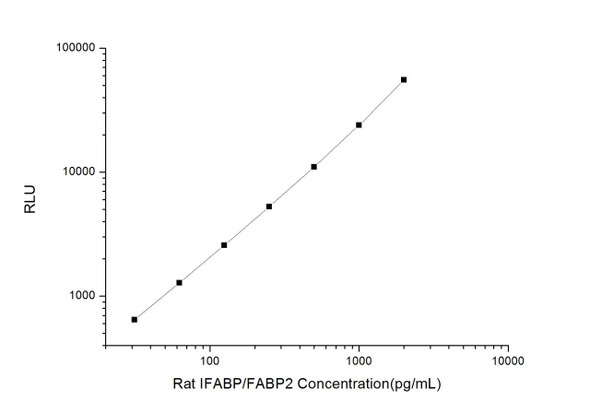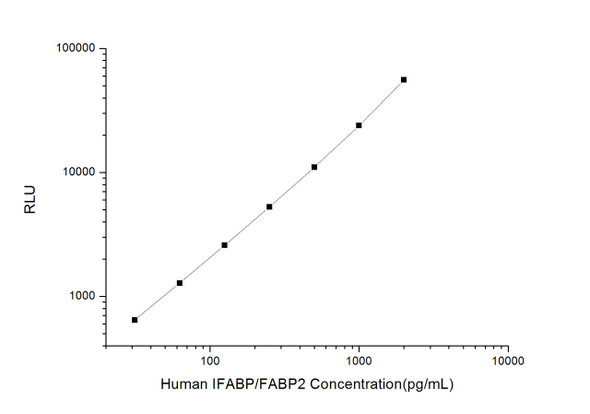Mouse Cell Signalling ELISA Kits 5
Mouse IFABP/FABP2 (Intestinal Fatty Acid Binding Protein) CLIA Kit (MOES00416)
- SKU:
- MOES00416
- Product Type:
- ELISA Kit
- ELISA Type:
- CLIA Kit
- Size:
- 96 Assays
- Sensitivity:
- 18.75pg/mL
- Range:
- 31.25-2000pg/mL
- ELISA Type:
- Sandwich
- Synonyms:
- FABPI, I-FABP
- Reactivity:
- Mouse
- Sample Type:
- Serum, plasma and other biological fluids
- Research Area:
- Signal Transduction
Description
| Assay type: | Sandwich |
| Format: | 96T |
| Assay time: | 4.5h |
| Reactivity: | Mouse |
| Detection method: | Chemiluminescence |
| Detection range: | 31.25-2000 pg/mL |
| Sensitivity: | 18.75 pg/mL |
| Sample volume: | 100µL |
| Sample type: | Serum, plasma and other biological fluids |
| Repeatability: | CV < 15% |
| Specificity: | This kit recognizes Mouse IFABP/FABP2 in samples. No significant cross-reactivity or interference between Mouse IFABP/FABP2 and analogues was observed. |
This kit uses Sandwich-CLIA as the method. The micro CLIA plate provided in this kit has been pre-coated with an antibody specific to Mouse IFABP/FABP2. Standards or samples are added to the appropriate micro CLIA plate wells and combined with the specific antibody. Then a biotinylated detection antibody specific for Mouse IFABP/FABP2 and Avidin-Horseradish Peroxidase (HRP) conjugate are added to each micro plate well successively and incubated. Free components are washed away. The substrate solution is added to each well. Only those wells that contain Mouse IFABP/FABP2, biotinylated detection antibody and Avidin-HRP conjugate will appear fluorescence. The Relative light unit (RLU) value is measured spectrophotometrically by the Chemiluminescence immunoassay analyzer. The RLU value is positively associated with the concentration of Mouse IFABP/FABP2. The concentration of Mouse IFABP/FABP2 in the samples can be calculated by comparing the RLU of the samples to the standard curve.
| UniProt Protein Function: | FABP are thought to play a role in the intracellular transport of long-chain fatty acids and their acyl-CoA esters. FABP2 is probably involved in triglyceride-rich lipoprotein synthesis. Binds saturated long-chain fatty acids with a high affinity, but binds with a lower affinity to unsaturated long-chain fatty acids. FABP2 may also help maintain energy homeostasis by functioning as a lipid sensor. |
| NCBI Summary: | The protein encoded by this gene is part of the fatty acid binding protein family (FABP). FABPs are a family of small, highly conserved, cytoplasmic proteins that bind long-chain fatty acids and other hydrophobic ligands and participate in fatty acid uptake, transport, and metabolism. This protein functions within enterocytes, possibly to sense lipids as part of energy homeostasis. In humans polymorphisms are associated with increased fat oxidation and insulin resistance. In mice deficiency of this gene alters body weight in a gender-specific manner and causes hyperinsulinemia. [provided by RefSeq, Jan 2013] |
| UniProt Code: | P55050 |
| NCBI GenInfo Identifier: | 6679737 |
| NCBI Gene ID: | 14079 |
| NCBI Accession: | NP_032006. 1 |
| UniProt Related Accession: | P55050 |
| Molecular Weight: | 15,126 Da |
| NCBI Full Name: | fatty acid-binding protein, intestinal |
| NCBI Synonym Full Names: | fatty acid binding protein 2, intestinal |
| NCBI Official Symbol: | Fabp2 |
| NCBI Official Synonym Symbols: | Fabpi; I-FABP |
| NCBI Protein Information: | fatty acid-binding protein, intestinal |
| UniProt Protein Name: | Fatty acid-binding protein, intestinal |
| UniProt Synonym Protein Names: | Fatty acid-binding protein 2; Intestinal-type fatty acid-binding protein; I-FABP |
| Protein Family: | Fatty acid-binding protein |
| UniProt Gene Name: | Fabp2 |
As the RLU values of the standard curve may vary according to the conditions of the actual assay performance (e. g. operator, pipetting technique, washing technique or temperature effects), the operator should establish a standard curve for each test. Typical standard curve and data is provided below for reference only.
| Concentration (pg/mL) | RLU | Average | Corrected |
| 2000 | 53248 58194 | 55721 | 55693 |
| 1000 | 22437 25511 | 23974 | 23946 |
| 500 | 11439 10625 | 11032 | 11004 |
| 250 | 5280 5308 | 5294 | 5266 |
| 125 | 2711 2505 | 2608 | 2580 |
| 62.5 | 1347 1275 | 1311 | 1283 |
| 31.25 | 637 711 | 674 | 646 |
| 0 | 27 29 | 28 | -- |
Precision
Intra-assay Precision (Precision within an assay): 3 samples with low, mid range and high level Mouse IFABP/FABP2 were tested 20 times on one plate, respectively.
Inter-assay Precision (Precision between assays): 3 samples with low, mid range and high level Mouse IFABP/FABP2 were tested on 3 different plates, 20 replicates in each plate.
| Intra-assay Precision | Inter-assay Precision | |||||
| Sample | 1 | 2 | 3 | 1 | 2 | 3 |
| n | 20 | 20 | 20 | 20 | 20 | 20 |
| Mean (pg/mL) | 105.84 | 278.79 | 740.45 | 109.83 | 302.01 | 671.59 |
| Standard deviation | 8.73 | 31.03 | 48.65 | 13.72 | 35.58 | 62.86 |
| C V (%) | 8.25 | 11.13 | 6.57 | 12.49 | 11.78 | 9.36 |
Recovery
The recovery of Mouse IFABP/FABP2 spiked at three different levels in samples throughout the range of the assay was evaluated in various matrices.
| Sample Type | Range (%) | Average Recovery (%) |
| Serum (n=5) | 94-109 | 101 |
| EDTA plasma (n=5) | 101-116 | 107 |
| Cell culture media (n=5) | 89-104 | 95 |
Linearity
Samples were spiked with high concentrations of Mouse IFABP/FABP2 and diluted with Reference Standard & Sample Diluent to produce samples with values within the range of the assay.
| Serum (n=5) | EDTA plasma (n=5) | Cell culture media (n=5) | ||
| 1:2 | Range (%) | 91-106 | 97-112 | 97-112 |
| Average (%) | 99 | 103 | 103 | |
| 1:4 | Range (%) | 103-116 | 93-108 | 89-102 |
| Average (%) | 109 | 100 | 95 | |
| 1:8 | Range (%) | 86-100 | 88-103 | 92-106 |
| Average (%) | 92 | 94 | 97 | |
| 1:16 | Range (%) | 86-97 | 94-109 | 94-109 |
| Average (%) | 91 | 101 | 99 |
An unopened kit can be stored at 4°C for 1 month. If the kit is not used within 1 month, store the items separately according to the following conditions once the kit is received.
| Item | Specifications | Storage |
| Micro CLIA Plate(Dismountable) | 8 wells ×12 strips | -20°C, 6 months |
| Reference Standard | 2 vials | |
| Concentrated Biotinylated Detection Ab (100×) | 1 vial, 120 µL | |
| Concentrated HRP Conjugate (100×) | 1 vial, 120 µL | -20°C(shading light), 6 months |
| Reference Standard & Sample Diluent | 1 vial, 20 mL | 4°C, 6 months |
| Biotinylated Detection Ab Diluent | 1 vial, 14 mL | |
| HRP Conjugate Diluent | 1 vial, 14 mL | |
| Concentrated Wash Buffer (25×) | 1 vial, 30 mL | |
| Substrate Reagent A | 1 vial, 5 mL | 4°C (shading light) |
| Substrate Reagent B | 1 vial, 5 mL | 4°C (shading light) |
| Plate Sealer | 5 pieces | |
| Product Description | 1 copy | |
| Certificate of Analysis | 1 copy |
- Set standard, test sample and control (zero) wells on the pre-coated plate and record theirpositions. It is recommended to measure each standard and sample in duplicate. Note: addall solutions to the bottom of the plate wells while avoiding contact with the well walls. Ensuresolutions do not foam when adding to the wells.
- Aliquot 100µl of standard solutions into the standard wells.
- Add 100µl of Sample / Standard dilution buffer into the control (zero) well.
- Add 100µl of properly diluted sample (serum, plasma, tissue homogenates and otherbiological fluids. ) into test sample wells.
- Cover the plate with the sealer provided in the kit and incubate for 90 min at 37°C.
- Aspirate the liquid from each well, do not wash. Immediately add 100µL of BiotinylatedDetection Ab working solution to each well. Cover the plate with a plate seal and gently mix. Incubate for 1 hour at 37°C.
- Aspirate or decant the solution from the plate and add 350µL of wash buffer to each welland incubate for 1-2 minutes at room temperature. Aspirate the solution from each well andclap the plate on absorbent filter paper to dry. Repeat this process 3 times. Note: a microplatewasher can be used in this step and other wash steps.
- Add 100µL of HRP Conjugate working solution to each well. Cover with a plate seal andincubate for 30 min at 37°C.
- Aspirate or decant the solution from each well. Repeat the wash process for five times asconducted in step 7.
- Add 100µL of Substrate mixture solution to each well. Cover with a new plate seal andincubate for no more than 5 min at 37°C. Protect the plate from light.
- Determine the RLU value of each well immediately.






